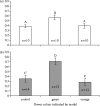Flower choice copying in bumblebees
- PMID: 17148244
- PMCID: PMC1626359
- DOI: 10.1098/rsbl.2005.0368
Flower choice copying in bumblebees
Abstract
We tested a hypothesis originating with Darwin that bees outside the nest exhibit social learning in flower choices. Naive bumblebees, Bombus impatiens, were allowed to observe trained bees or artificial bees forage from orange or green flowers. Subsequently, observers of bees on green flowers landed more often on green flowers than non-observing controls or observers of models on orange flowers. These results demonstrate that bumblebees can change flower choice by observations of non-nest mates, a novel form of social learning in insects that could provide unique benefits to the colony.
Figures


References
-
- Brosnan S.F, de Waal F.B.M. Socially learned preferences for differentially rewarded tokens in the brown Capuchin monkey (Cebus apella) J. Comp. Psychol. 2004;118:133–139. doi:10.1037/0735-7036.118.2.133 - DOI - PubMed
-
- Chapman R.E, Wang J, Bourke A.F.G. Genetic analysis of spatial foraging patterns and resource sharing in bumble bee pollinators. Mol. Ecol. 2003;12:2801–2808. doi:10.1046/j.1365-294X.2003.01957.x - DOI - PubMed
-
- D'Adamo P, Lozada M, Corley J. Conspecifics enhance attraction of Vespula germanica (Hymenoptera: Vespidae) foragers to food baits. Ann. Ent. Soc. Am. 2003;96:685–688. - PubMed
-
- Detrain C, Deneubourg J.L, Pasteels J.M. Birkhauser; Basel: 1999. Information processing in social insects.
-
- Dornhaus A, Chittka L. Information flow and regulation of foraging activity in bumblebees (Bombus spp.) Apidologie. 2004;35:183–192. doi:10.1051/apido:2004002 - DOI
MeSH terms
LinkOut - more resources
Full Text Sources
